Exploring the Evolution of Typhoon Lekima (2019) Moving Offshore Northeast of Taiwan with a Multi-Resolution Global Model
Abstract
1. Introduction
2. The Model and Experiments
2.1. The MPAS
2.2. Vortex Initialization
2.3. Lekima and Numerical Experiments
3. Simulation Results
3.1. Track and Intensity Simulations with Taiwan Terrain
3.2. Typhoon Simulations with and without the Taiwan Terrain
3.3. Forecast Sensitivity to Physical Parameterizations
3.4. Typhoon Circulation
3.5. Evolution of the Vortex Wind Speed
3.6. The Asymmetric Flow Affecting Tracks
4. Discussion
4.1. Azimuthal-Mean Angular Momentum Budget
4.2. Potential Vorticity Budget
4.3. Typhoon Translation with Perturbed Initial Conditions
4.4. Rapid Intensification Facilitated by Lower-Stratospheric Responses
5. Conclusions
Author Contributions
Funding
Institutional Review Board Statement
Informed Consent Statement
Data Availability Statement
Acknowledgments
Conflicts of Interest
References
- Wu, C.-C.; Kuo, Y.-H. Typhoons affecting Taiwan: Current understanding and future challenges. Bull. Am. Meteorol. Soc. 1999, 80, 67–80. [Google Scholar] [CrossRef]
- Hsu, L.-H.; Kuo, H.-C.; Fovell, R.G. On the geographic asymmetry of typhoon translation speed across the mountainous island of Taiwan. J. Atmos. Sci. 2013, 70, 1006–1022. [Google Scholar] [CrossRef]
- Chang, W.-J. The orographic effects induced by an island mountain range on propagating tropical cyclones. Mon. Weather Rev. 1982, 110, 1255–1270. [Google Scholar] [CrossRef]
- Bender, M.A.; Tuleya, R.E.; Kurihara, Y. A numerical study of the effect of island terrain on tropical cyclones. Mon. Weather Rev. 1987, 115, 130–155. [Google Scholar] [CrossRef]
- Yeh, T.-C.; Elsberry, R.L. Interaction of typhoons with the Taiwan orography. Part I: Upstream track deflections. Mon. Weather Rev. 1993, 121, 3193–3212. [Google Scholar] [CrossRef]
- Yeh, T.-C.; Elsberry, R.L. Interaction of typhoons with the Taiwan orography. Part II: Continuous and discontinuous tracks across the island. Mon. Weather Rev. 1993, 121, 3213–3233. [Google Scholar] [CrossRef]
- Lin, Y.-L.; Han, J.; Hamilton, D.W.; Huang, C.-Y. Orographic influence on a drifting cyclone. J. Atmos. Sci. 1999, 56, 534–562. [Google Scholar] [CrossRef]
- Kuo, H.-C.; Williams, R.; Chen, J.-H.; Chen, Y.-L. Topographic effects on barotropic vortex motion: No mean flow. J. Atmos. Sci. 2001, 58, 1310–1327. [Google Scholar] [CrossRef]
- Lin, Y.-L.; Ensley, D.B.; Chiao, S.; Huang, C.-Y. Orographic influences on rainfall and track deflection associated with the passage of a tropical cyclone. Mon. Weather Rev. 2002, 130, 2929–2950. [Google Scholar] [CrossRef]
- Lin, Y.-L.; Chen, S.-Y.; Hill, C.M.; Huang, C.-Y. Control parameters for the influence of a mesoscale mountain range on cyclone track continuity and deflection. J. Atmos. Sci. 2005, 62, 1849–1866. [Google Scholar] [CrossRef]
- Huang, C.-Y.; Lin, Y.-L. The influence of mesoscale mountains on vortex tracks: Shallow-water modeling study. Meteorol. Atmos. Phys. 2008, 101, 1–20. [Google Scholar] [CrossRef]
- Jian, G.-J.; Wu, C.-C. A numerical study of the track deflection of Supertyphoon Haitang (2005) prior to its landfall in Taiwan. Mon. Weather Rev. 2008, 136, 598–615. [Google Scholar] [CrossRef]
- Lin, Y.-L.; Savage, L.C., III. Effects of landfall location and the approach angle of a cyclone vortex encountering a mesoscale mountain range. J. Atmos. Sci. 2011, 68, 2095–2106. [Google Scholar] [CrossRef]
- Huang, Y.-H.; Wu, C.-C.; Wang, Y. The influence of island topography on typhoon track deflection. Mon. Weather Rev. 2011, 139, 1708–1727. [Google Scholar] [CrossRef]
- Wu, C.-C.; Li, T.-H.; Huang, Y.-H. Influence of mesoscale topography on tropical cyclone tracks: Further examination of the channeling effect. J. Atmos. Sci. 2015, 72, 3032–3050. [Google Scholar] [CrossRef]
- Tang, C.K.; Chan, J.C. Idealized simulations of the effect of Taiwan topography on the tracks of tropical cyclones with different sizes. Q. J. R. Meteorol. Soc. 2016, 142, 793–804. [Google Scholar] [CrossRef]
- Tang, C.K.; Chan, J.C. Idealized simulations of the effect of Taiwan topography on the tracks of tropical cyclones with different steering flow strengths. Q. J. R. Meteorol. Soc. 2016, 142, 3211–3221. [Google Scholar] [CrossRef]
- Huang, C.-Y.; Chen, C.-A.; Chen, S.-H.; Nolan, D.S. On the upstream track deflection of tropical cyclones past a mountain range: Idealized experiments. J. Atmos. Sci. 2016, 73, 3157–3180. [Google Scholar] [CrossRef][Green Version]
- Hsu, L.-H.; Su, S.-H.; Fovell, R.G.; Kuo, H.-C. On typhoon track deflections near the east coast of Taiwan. Mon. Weather Rev. 2018, 146, 1495–1510. [Google Scholar] [CrossRef]
- Huang, K.-C.; Wu, C.-C. The impact of idealized terrain on upstream tropical cyclone track. J. Atmos. Sci. 2018, 75, 3887–3910. [Google Scholar] [CrossRef]
- Huang, C.-Y.; Huang, C.-H.; Skamarock, W.C. Track deflection of Typhoon Nesat (2017) as realized by multiresolution simulations of a global model. Mon. Weather Rev. 2019, 147, 1593–1613. [Google Scholar] [CrossRef]
- Chen, S.-Y.; Shih, C.-P.; Huang, C.-Y.; Teng, W.-H. An impact study of GNSS RO data on the prediction of Typhoon Nepartak (2016) using a multiresolution global model with 3D-hybrid data assimilation. Weather Forecast. 2021, 36, 957–977. [Google Scholar]
- Huang, C.-Y.; Lin, J.-Y.; Skamarock, W.C.; Chen, S.-Y. Typhoon forecasts with dynamic vortex initialization using an unstructured mesh global model. Mon. Weather Rev. 2022, in press. [Google Scholar] [CrossRef]
- Huang, C.-Y.; Ruan, C.-C.; Kuo, H.-C.; Chen, J.-H. Track deflection of Typhoon Maria (2018) during a westbound passage offshore of northern Taiwan: Topographic influence. Mon. Weather Rev. 2020, 148, 4519–4544. [Google Scholar] [CrossRef]
- Huang, C.-Y.; Sha, S.-H.; Kuo, H.-C. A modeling study of Typhoon Lekima (2019) with the topographic influence of Taiwan. Mon. Weather Rev. 2022, 150, 1993–2011. [Google Scholar] [CrossRef]
- Huang, C.-Y.; Lin, J.-Y.; Kuo, H.-C.; Chen, D.-S.; Hong, J.-S.; Hsiao, L.-F.; Chen, S.-Y. A numerical study for Tropical Cyclone Atsani (2020) past offshore of southern Taiwan under topographic influences. Atmosphere 2022, 13, 618. [Google Scholar] [CrossRef]
- Skamarock, W.C.; Klemp, J.B.; Duda, M.G.; Fowler, L.D.; Park, S.-H.; Ringler, T.D. A multiscale nonhydrostatic atmospheric model using centroidal Voronoi tesselations and C-grid staggering. Mon. Weather Rev. 2012, 140, 3090–3105. [Google Scholar] [CrossRef]
- Kaplan, J.; DeMaria, M. Large-scale characteristics of rapidly intensifying tropical cyclones in the North Atlantic basin. Weather Forecast. 2003, 18, 1093–1108. [Google Scholar] [CrossRef]
- Shi, D.; Chen, G.; Wang, K.; Bi, X.; Chen, K. Evaluation of two initialization schemes for simulating the rapid intensification of Typhoon Lekima (2019). Adv. Atmos. Sci. 2020, 37, 987–1006. [Google Scholar] [CrossRef]
- Shi, D.; Chen, G. Double warm-core structure and potential vorticity diagnosis during the rapid intensification of Supertyphoon Lekima (2019). J. Atmos. Sci. 2021, 78, 2471–2492. [Google Scholar] [CrossRef]
- Yang, Y.-T.; Kuo, H.-C.; Hendricks, E.A.; Peng, M.S. Structural and intensity changes of concentric eyewall typhoons in the western North Pacific basin. Mon. Weather Rev. 2013, 141, 2632–2648. [Google Scholar] [CrossRef]
- Nguyen, T.C.; Huang, C.-Y. A comparative modeling study of Supertyphoons Mangkhut and Yutu (2018) past the Philippines with ocean-coupled HWRF. Atmosphere 2021, 12, 1055. [Google Scholar] [CrossRef]
- Wu, L.; Wang, B. A potential vorticity tendency diagnostic approach for tropical cyclone motion. Mon. Weather Rev. 2000, 128, 1899–1911. [Google Scholar] [CrossRef]
- Tsujino, S.; Kuo, H.-C. Potential vorticity mixing and rapid intensification in the numerically simulated Supertyphoon Haiyan (2013). J. Atmos. Sci. 2020, 77, 2067–2090. [Google Scholar] [CrossRef]
- Wang, H.; Wang, Y. A numerical study of Typhoon Megi (2010). Part I: Rapid intensification. Mon. Weather Rev. 2014, 142, 29–48. [Google Scholar] [CrossRef]
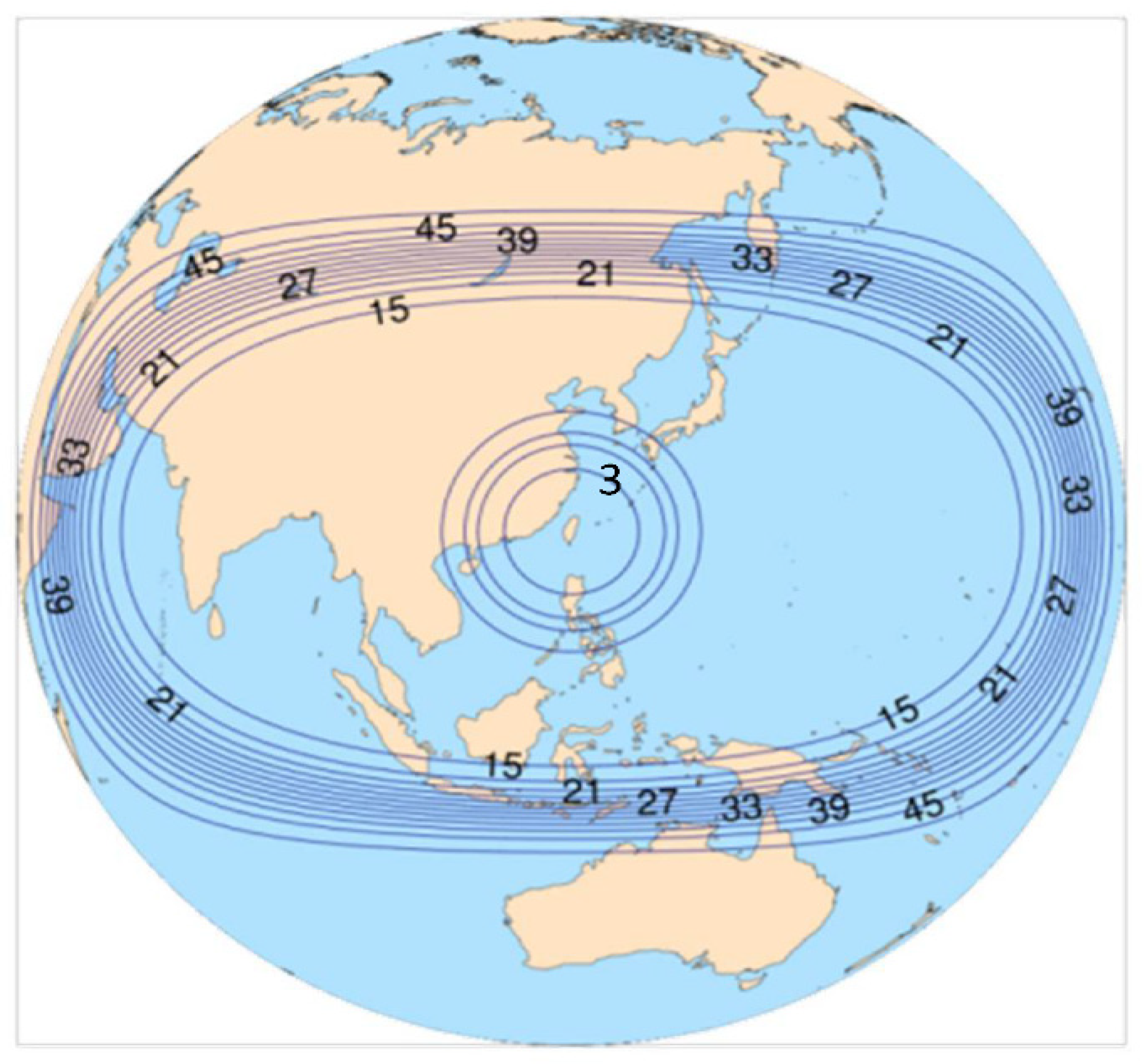
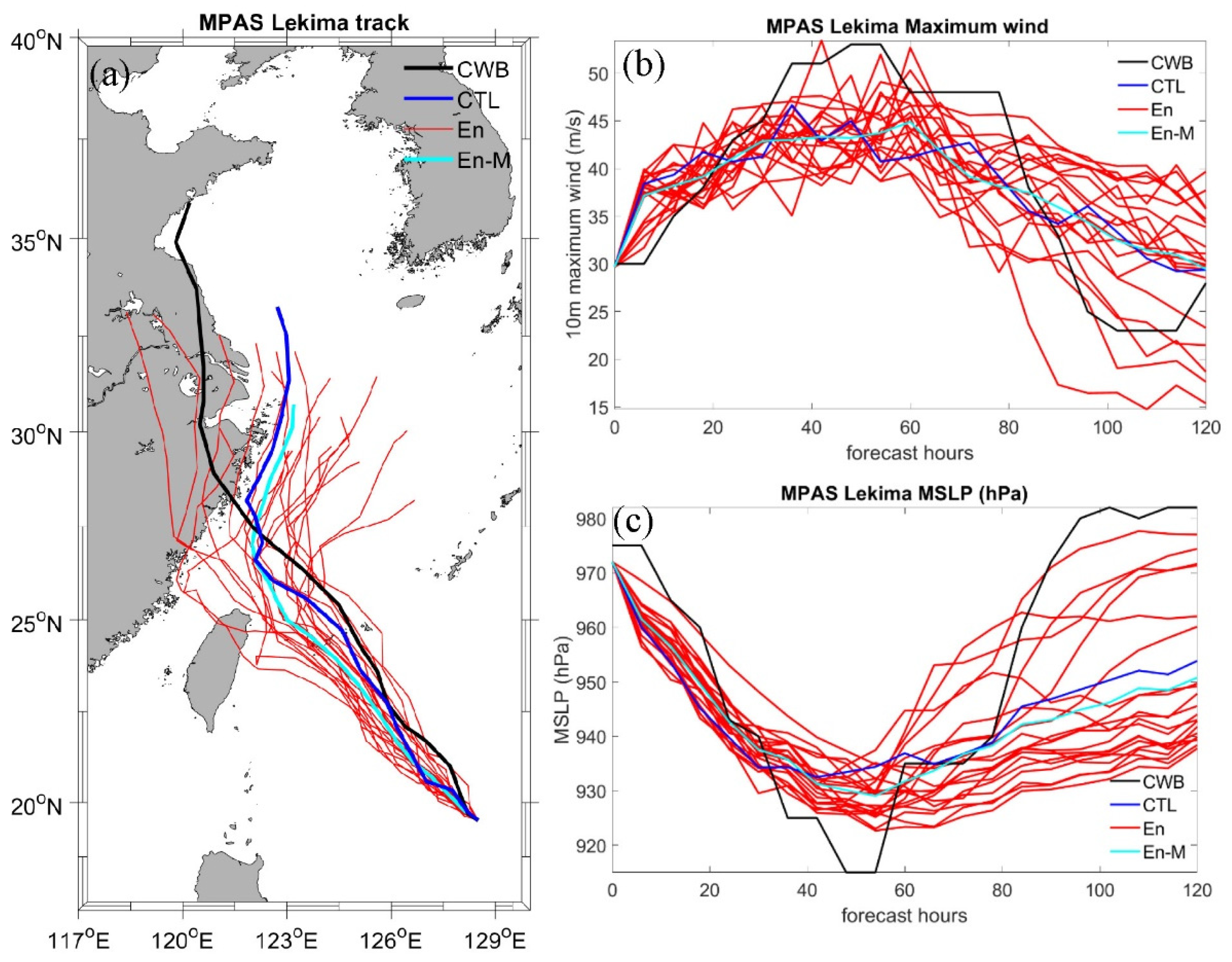
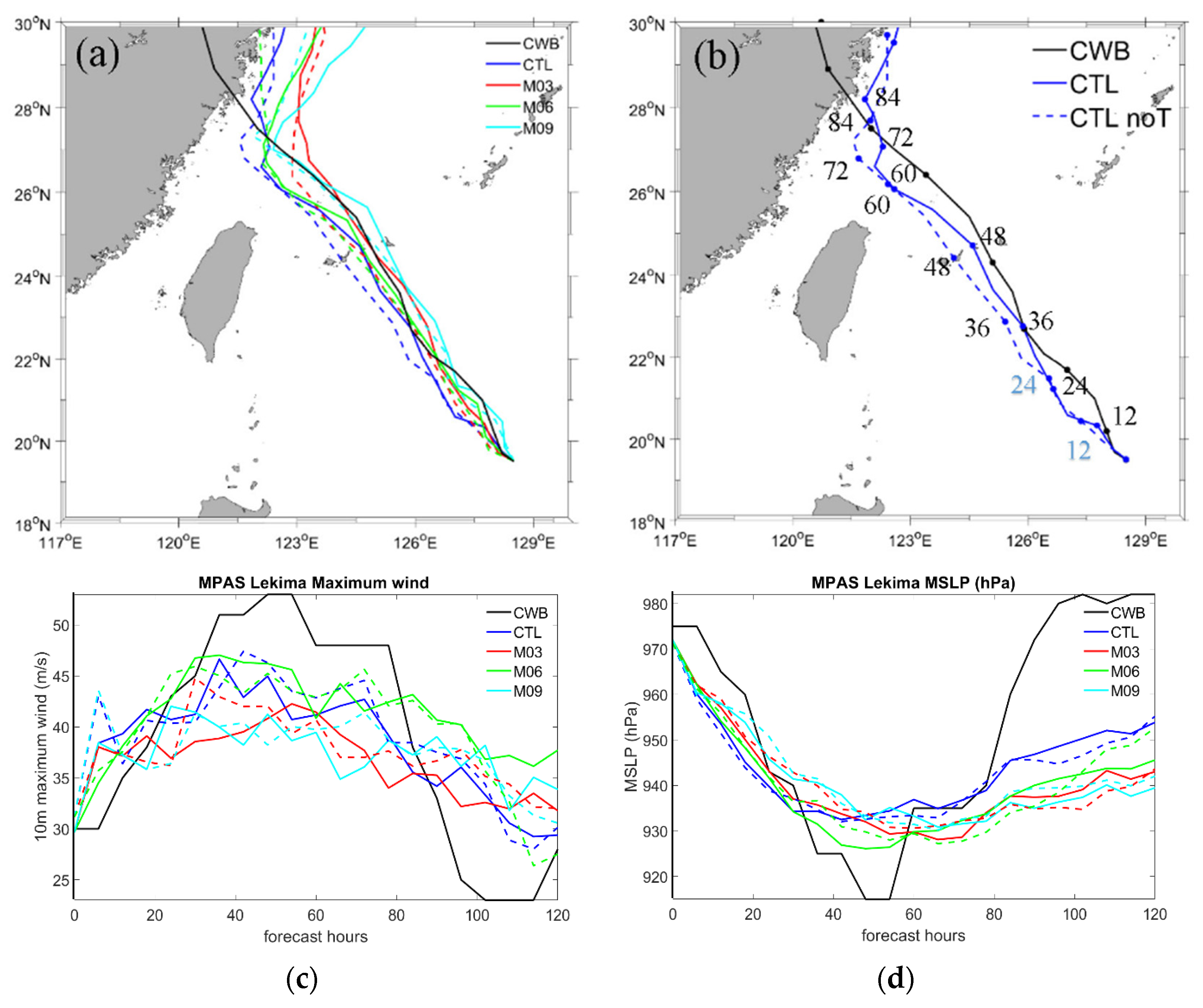
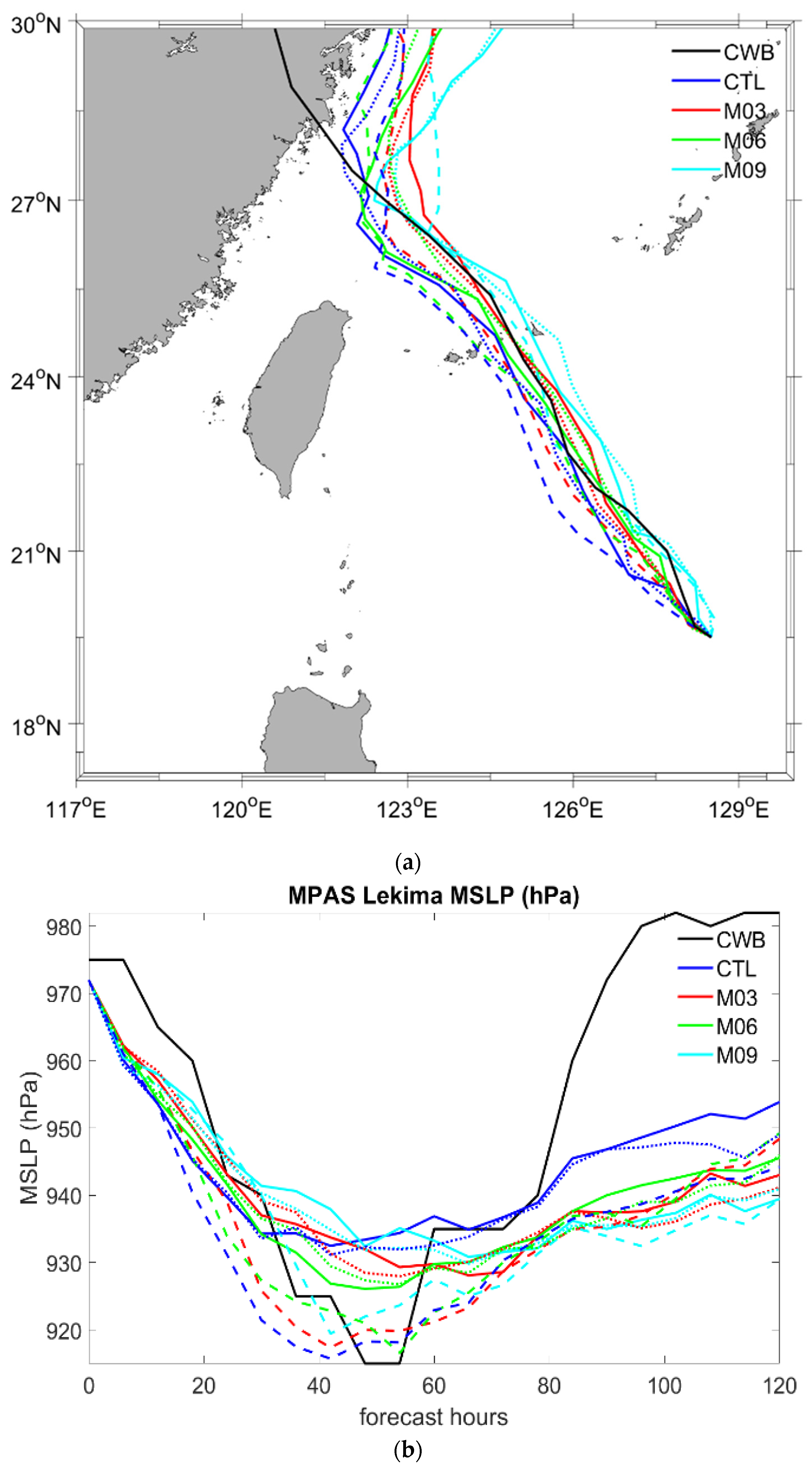
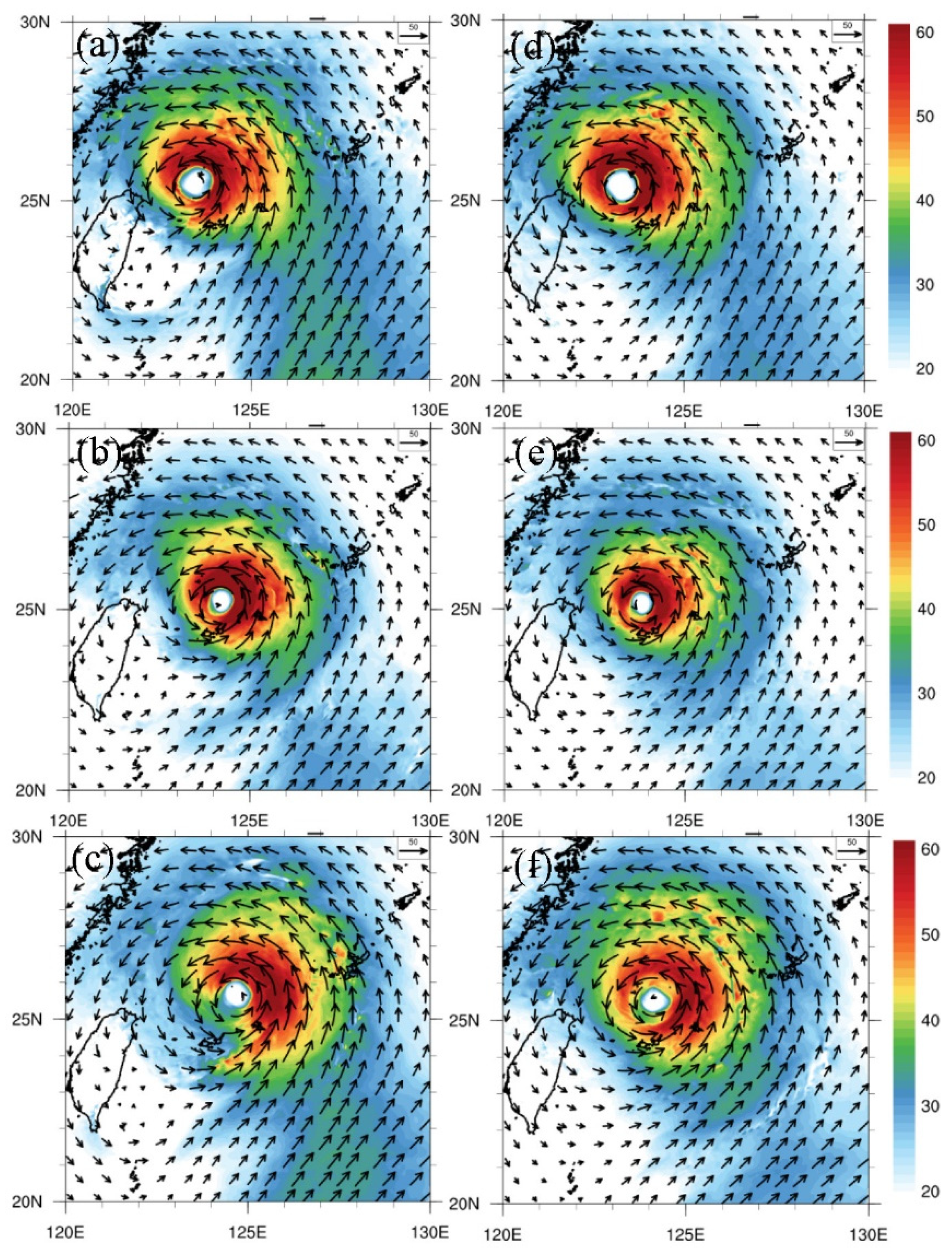
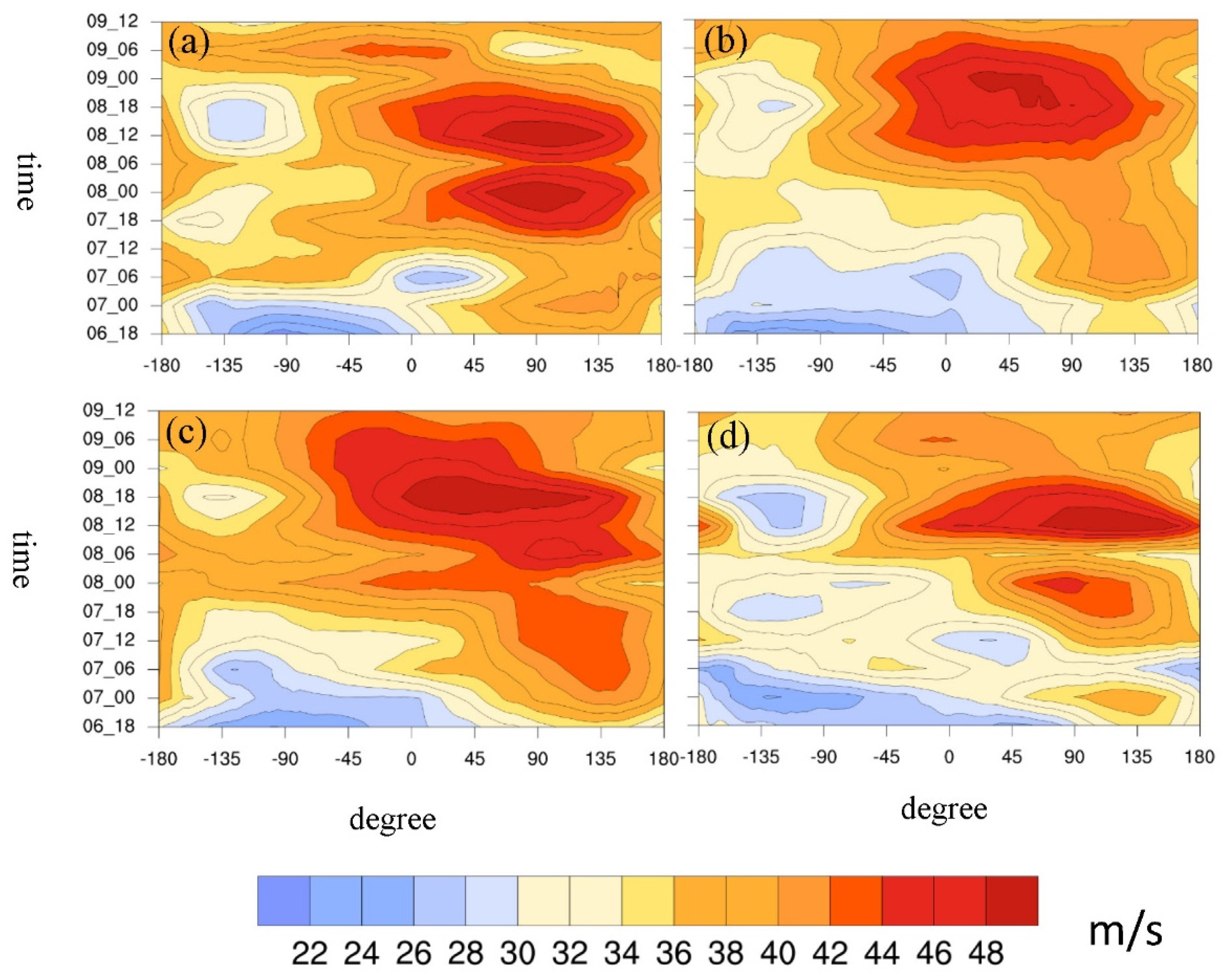
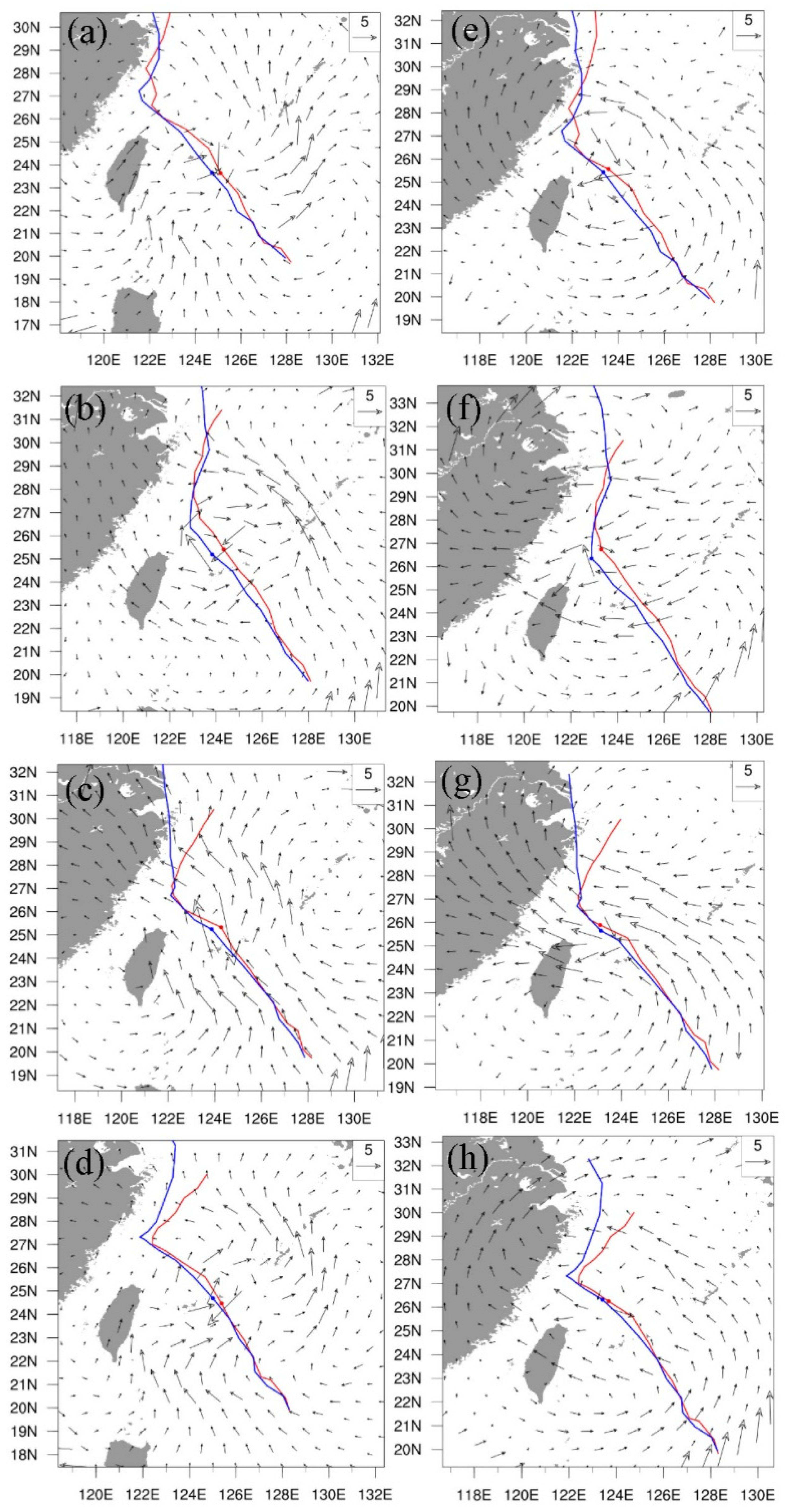
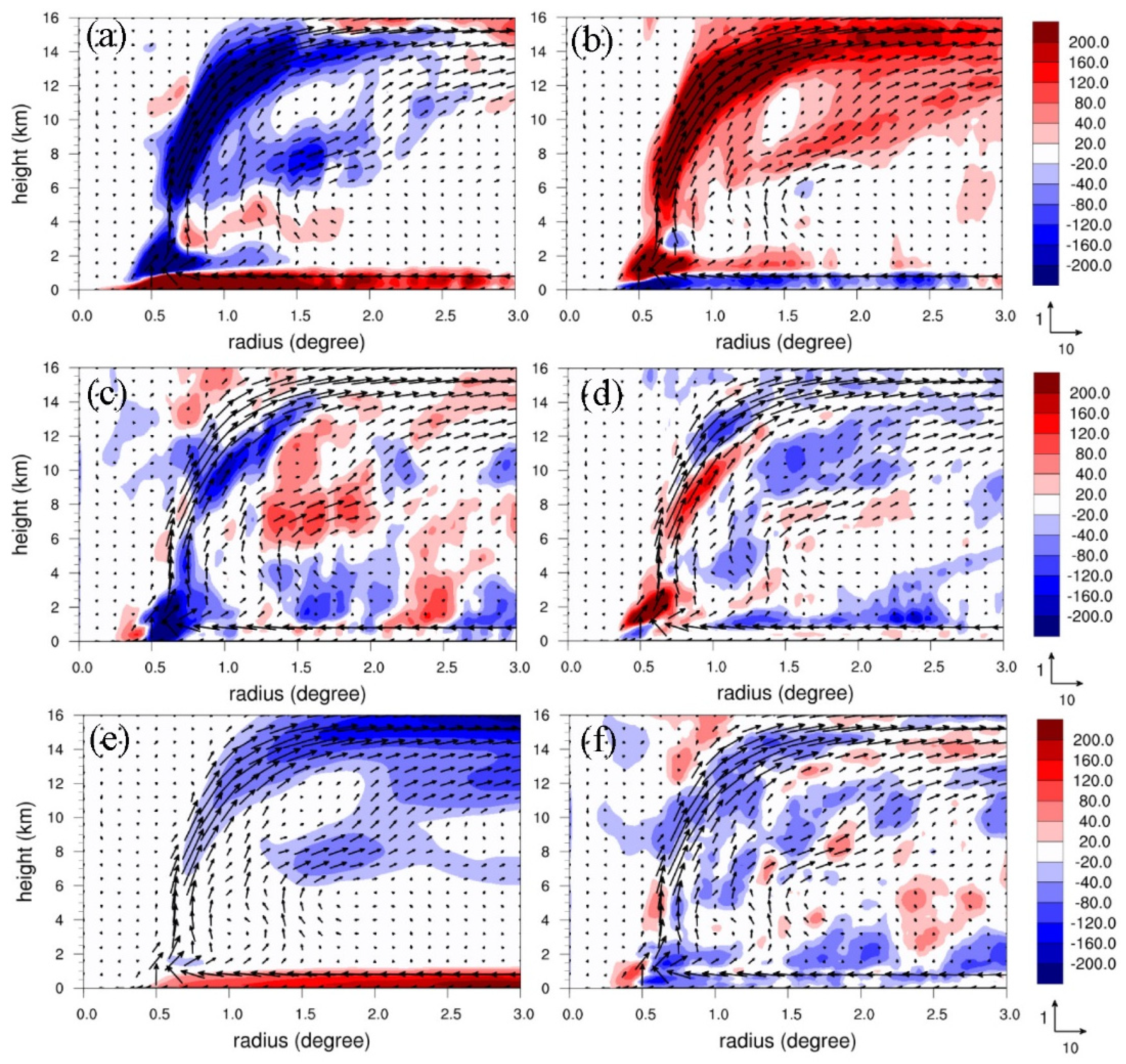
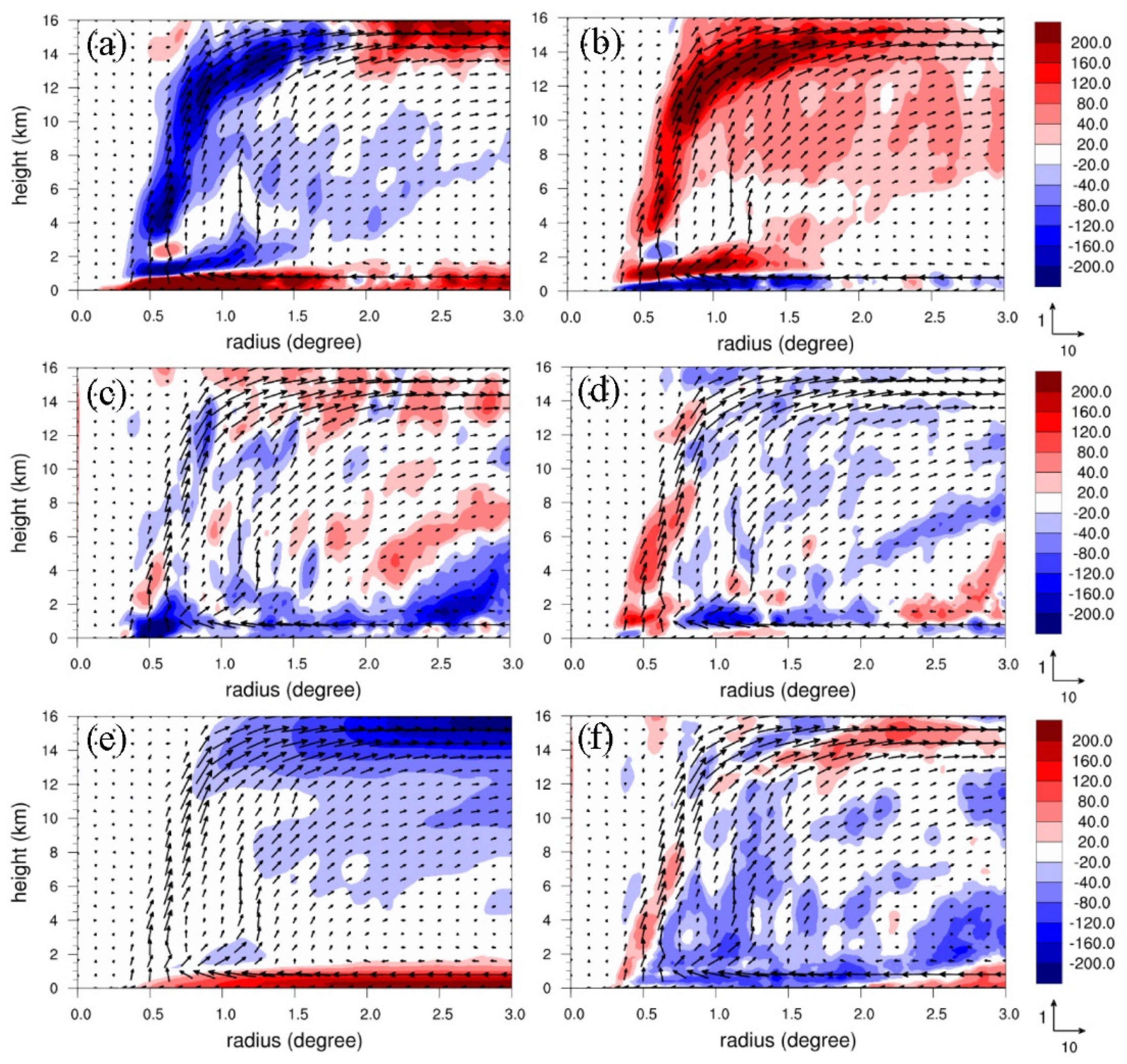

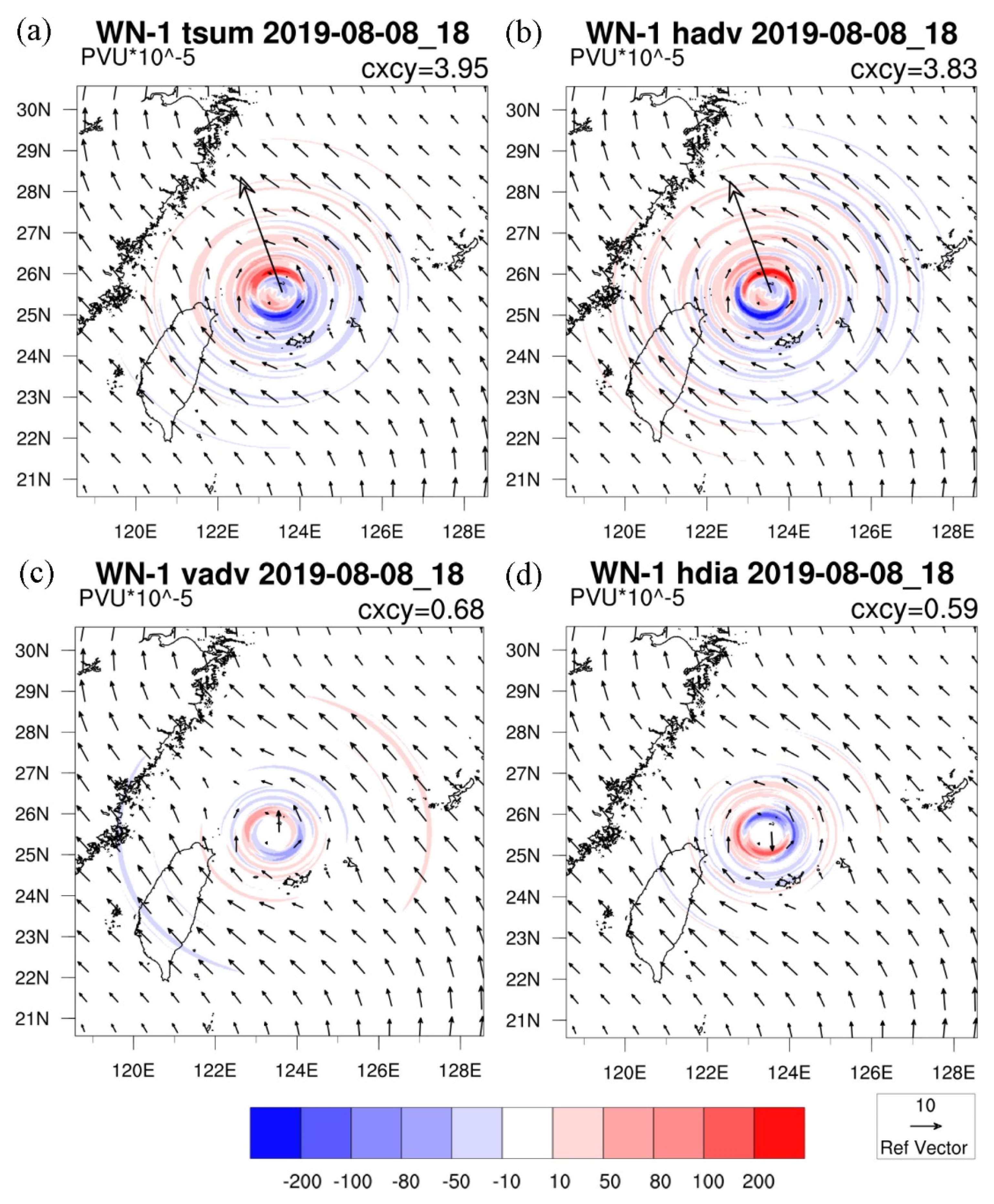
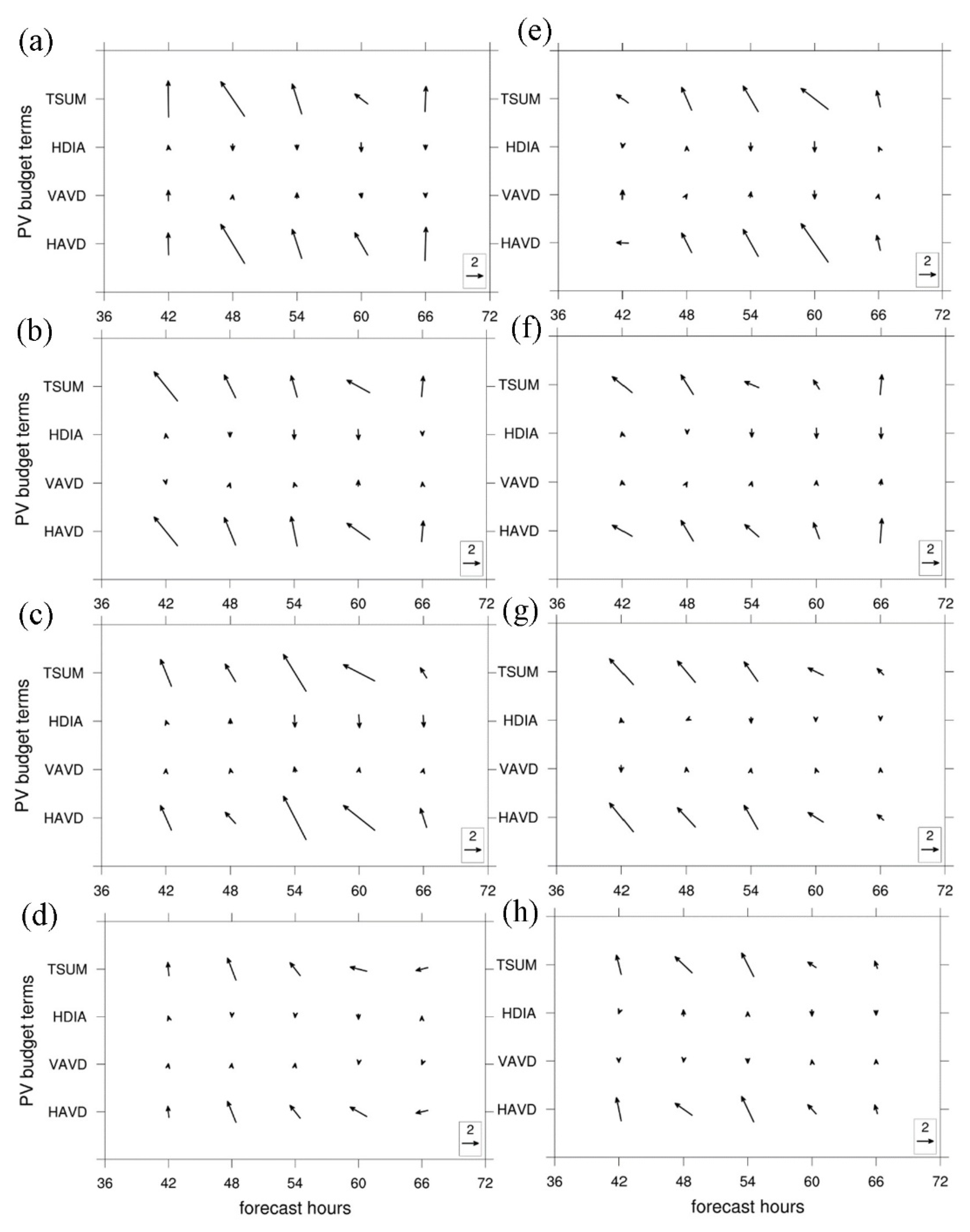
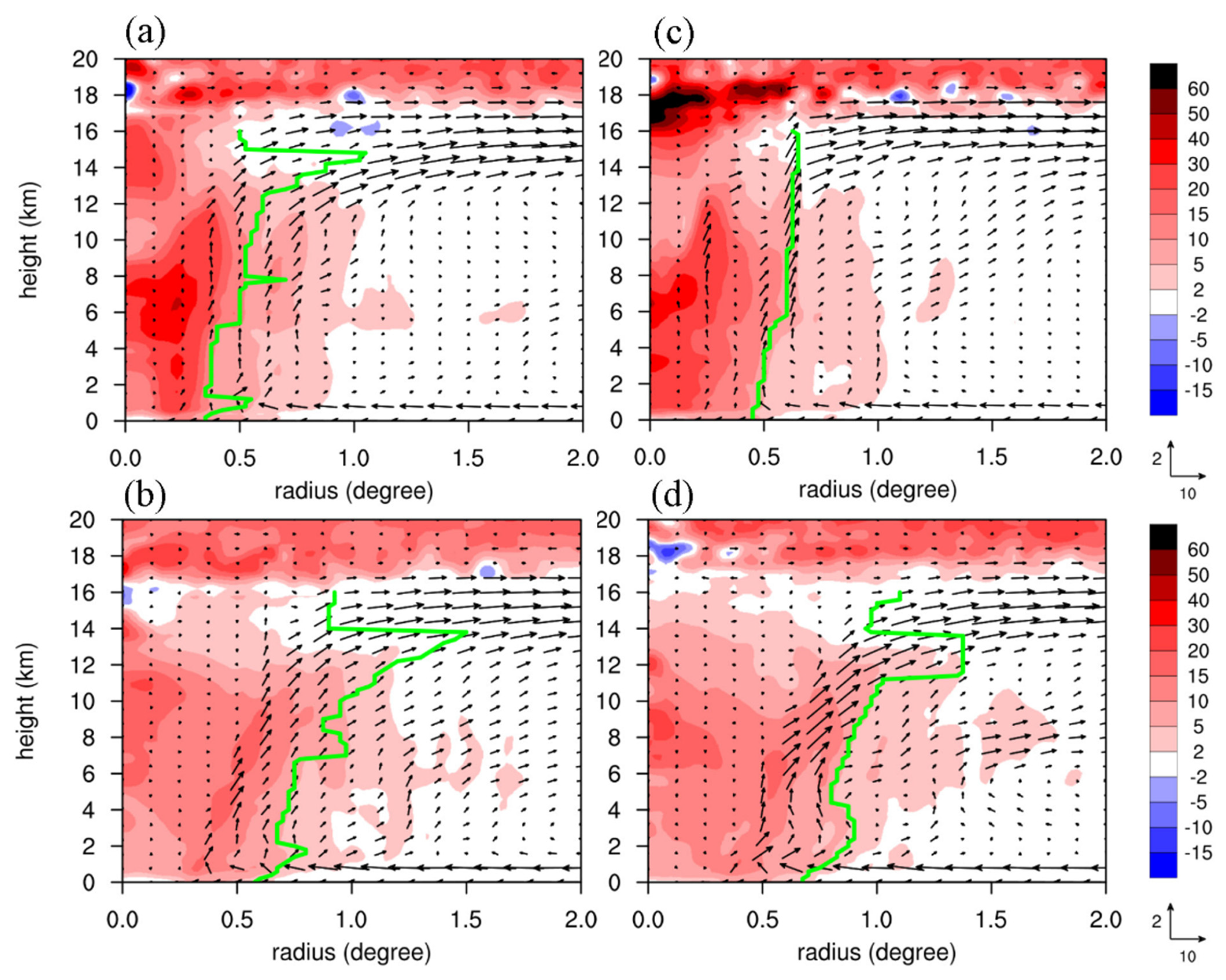
Publisher’s Note: MDPI stays neutral with regard to jurisdictional claims in published maps and institutional affiliations. |
© 2022 by the authors. Licensee MDPI, Basel, Switzerland. This article is an open access article distributed under the terms and conditions of the Creative Commons Attribution (CC BY) license (https://creativecommons.org/licenses/by/4.0/).
Share and Cite
Huang, C.-Y.; Chang, C.-H.; Kuo, H.-C. Exploring the Evolution of Typhoon Lekima (2019) Moving Offshore Northeast of Taiwan with a Multi-Resolution Global Model. Atmosphere 2022, 13, 1817. https://doi.org/10.3390/atmos13111817
Huang C-Y, Chang C-H, Kuo H-C. Exploring the Evolution of Typhoon Lekima (2019) Moving Offshore Northeast of Taiwan with a Multi-Resolution Global Model. Atmosphere. 2022; 13(11):1817. https://doi.org/10.3390/atmos13111817
Chicago/Turabian StyleHuang, Ching-Yuang, Chau-Hsiang Chang, and Hung-Chi Kuo. 2022. "Exploring the Evolution of Typhoon Lekima (2019) Moving Offshore Northeast of Taiwan with a Multi-Resolution Global Model" Atmosphere 13, no. 11: 1817. https://doi.org/10.3390/atmos13111817
APA StyleHuang, C.-Y., Chang, C.-H., & Kuo, H.-C. (2022). Exploring the Evolution of Typhoon Lekima (2019) Moving Offshore Northeast of Taiwan with a Multi-Resolution Global Model. Atmosphere, 13(11), 1817. https://doi.org/10.3390/atmos13111817




